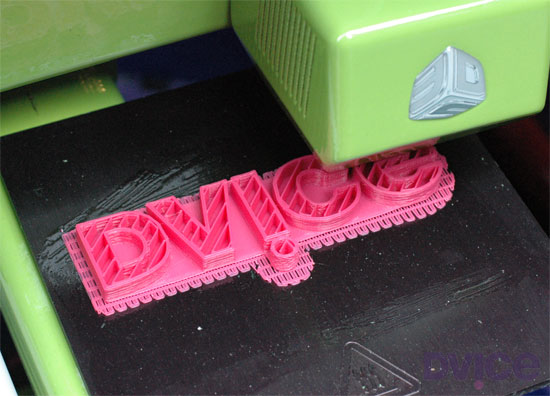Even your most advanced toaster won't ask that much of you these days. No matter what you're browning, it all boils down to lowering that lever and knowing that something is about to get toasty.
So, how do you make a complex piece of technology such as a 3D printer easy enough for everyone to use, like a toaster? Well, to start, you focus around a one-button design. There are 3D printers on the way that want you to be able to start fabricating cool stuff just like that — just with one button. For the most part, it really can be that easy.
Here we preview 3D System's forthcoming Cube 3D printer, which is looking toward a nearer-than-you-think future where 3D fabrication is commonplace and something anyone can do.
With One Press Of This Button
If there really is a 3D printing at home revolution waiting to happen, then 3D printers need to sort out two big barriers to entry: 1) the steep learning curve one must overcome to use the technology and 2) the capability of easily providing people with useful stuff to print.
While there are a number of options available and on the way, the trailblazer for 3D printing at home was Makerbot's Thing-O-Matic, followed up by the group's more versatile Replicator. The Thing-O-Matic epitomizes the 3D printer as geared toward hobbyists: it's industrial looking, requires technical know-how to get started and — though you could buy them fully assembled — the Thing-O-Matic was designed to be put together by someone who can solder. With the Replicator, Makerbot hasn't left its hobbyists behind, offering a bigger build space and two-color printing, but the platform now comes fully assembled and tested, and Makerbot's robust and growing Thingiverse makes finding designs to print easy and free.
That same thinking — making 3D printing easier out of the box — is shared by 3D Systems but taken along a little farther with the Cube. The Cube comes in a box like any old gadget on a shelf. It also doesn't look industrial and tinkery like other 3D printers, appearing a lot more like a desktop PC or a sewing machine. Where the Replicator would be at home in your workshop or garage, the Cube can sit on a kitchen counter next to your toaster. The Cube also connects to your home network via Wi-Fi, meaning you can use your PC to push new designs over to it, although you don't need a PC to get it to work.
The Cube has a build space that's 5.5-inches all around (length, width and height), which makes it perfect for action figures, cups, jewelry and anything small. Larger objects can also be made, you just need to print them out in smaller pieces and put them together. The Cube will come paired with different apps and software to help you design specific objects. For instance, one app we saw was like Build-A-Bear, but you were putting together your own robot instead.
In our video below, 3D Systems Social Media Manager Adam Reichental walks us through just how easy it is to fire the Cube up.
If Apple's App Store Sold 3D Objects
The real difference between the Cube and its hobbyist competitors is how you discover objects to print. For 3D printing enthusiasts, Thingiverse represents the easiest go-to. Outside of Thingiverse and Google-fishing for objects, you're really only left with the option of making your own designs.
3D System's solution? Cubify, a Thingiverse-like site with some crucial differences.
Whereas objects on Thingiverse are free, on Cubify they aren't. Think of Cubify as the Apple App Store of the 3D printing world — it's curated. Designs uploaded to the site are checked out individually before they're approved, and any obscene or copyright infringing templates won't get through. This also allows 3D Systems to test the designs and make sure they're ready to print with the Cube, taking out some of the guesswork on your end.
You buy the 3D models you want to print, which range from a few bucks to this $155 oil rig design, which is the most expensive model we could find. Cubify also lets folks who don't own 3D printers buy objects, and 3D Systems will print it out for them and mail it over. That service also starts out cheap, and goes all the way up to this $8,799 table, which would take quite a while to print out in small chunks using the Cube; 3D Systems also operates an industrial printing arm for heavier duty print jobs. One upside to charging for 3D objects: you support the designers. Like app makers, 3D modelers will get a cut of the cash for objects sold.
Using the Cube doesn't mean you have to use Cubify, however. Any printable 3D model that conforms to the Cube's build area should work. That said, paired up with Cubify, the Cube promises an experience that is as easy as browsing for a design on your computer, sending it to the Cube via Wi-Fi and then printing that object out with the touch of a button.
How To Get One
The 3D Systems Cube 3D printer is available for a $1,299 pre-order now and starts shipping this Friday, May 25.



